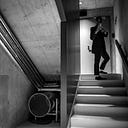Artwork for Everything Not Saved Will Be Lost — Part I by Foals feels like a powerful environmental statement
Artistic sleeve moving between vivid art-installation and an essay about the current state of our environment.
The photo of Vicente Muñoz comes from his infrared photo series called Sublimis. According to him, this project explores “the inevitable struggle of a man against nature — his desire to control and tame it through the constant thrust of urbanization.” A pink palm dominates the image, classic urban architecture is hiding behind. It looks like a slightly surrealist painting or a hyper-realistic photo, but the most important fact is how much this view into the relationship between the natural beauty and the unspectacular, residential type of building communicates the philosophy of Muñoz’s series and of the album title itself — Everything Not Saved Will Be Lost. The title, by the way, sounds like a very simple but important environmental statement, especially in these thickened plastic days.
Muñoz writes that the images from his series are dramatized by this “vibrant red colour, a product of an interpretation of the infrared signal of the film.” The infrared film was originally designed in collaboration with the USArmy for WWII in the early 40s. This special technology was able to register infrared light which is invisible to the naked eye. It was able to identify a hidden enemy in the open landscape. There is a strong message in its simplicity: humans repeatedly attack their natural environment and Muñoz tags this with surrealistic beauty and a little bit of irony, transforming nature into an un-protected territory which could end up destroyed by ourselves. It’s an artistic warning.
Originally, Muñoz borrowed this symbolic use of infrared film from Richard Mosse’s extraordinary video installation called The Enclave (2013). Mosse used an extinct type of 16mm infrared film and documented the war in the Democratic Republic of Congo where 5,4 million people died between 1998 and 2003. According to his words, he wanted “to register the invisible and make it visible.”
This hugely influential piece of committed art was premiered at the 2013 Venice Biennale in the Irish Pavilion. It had the power to drag you into the unknown hell which was strongly marginalized by the world media. When you got out of this absorbing area where documentary images looked like a series of brutal moving paintings, you were exhausted but also enriched. In some ways, I could find some similarities there with the intense exhibition called Invasion 1968 by Josef Koudelka at the National Gallery in Prague, Czech Republic. When you stepped into the dark halls, you were immediately surrounded by disorganized sounds from the projection screens with black-white photographs from the Warsaw Pact troops invasion into Prague. Both experiences were much more physical than the ordinary “looking-at-art” type of thing.
It is pleasant to realize that a band like Foals consciously works with all these themes not just musically but also visually and lets an artist like Muñoz get involved. His art is not only beautiful but also exceeding into an important phenomenon relating to all of us. That is definitely not a common approach you can expect from the contemporary world of mainstream music.
